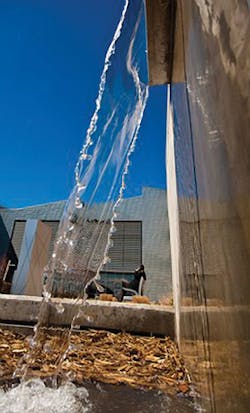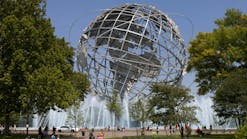From net zero energy buildings come strategies that can help make for smaller mechanical systems in a building’s interior and help reduce energy costs overall. While a net-zero energy building may not be your goal, adopting strategies from the net zero energy template can go a long way toward energy efficiency and reducing costs.
The Warren County, KY, Board of Education has collaborated on a number of successful sustainable schools over the years. Five of them have received the Energy Star designation for energy efficiency, including the first insulated concrete form (ICF) school in the state, the most energy-efficient school, and its latest project, net-zero energy Richardsville elementary, which was designed around a high-performance building envelope, active daylighting, geothermal HVAC, and site-produced renewable energy.
Elements of the envelope include a compact design that reduced the amount of perimeter walls and features super-insulated ICF walls and an R32 roof. An already-reduced HVAC load was further reduced by eliminating large volumes of attic space, situating the “high bay” areas of the building, the gym, cafeteria, and media center in the center of the project’s “doughnut” plan and incorporating heat pumps in mechanical closets between classrooms. Energy is produced by solar photovoltaics on the roof that supply 300 kW of power, the excess of which is sold put back into the grid. Automated dimming controls and occupancy sensors along with wireless computer technology and carbon dioxide (CO2) monitoring also help reduce the overall energy load.
“Net-zero energy buildings require a lot of attention to detail,” says Shanti Pless, senior research engineer at the National Renewable Energy Laboratory (NREL) in Golden, CO. “And the envelope is always the best place to start. If you can design your architecture and your envelope to get as much load reduction and efficiency as possible, this means smaller mechanical systems and more efficiency and simpler systems overall.”
Harvey Sachs, Senior Fellow at the American Council for an Energy Efficient Economy (ACEEE), is one with Pless on details. “Energy efficiency isn’t about home runs. It’s about a lot of singles and very good defense. The first goal is to understand the physiology of your building, and the best way to do that is to have someone knowledgeable do a building evaluation. A few thousand dollars to get a good understanding of the building is a much better investment than spending tens to hundreds of thousands of dollars on scatter-shot renovations.”
As far as choosing a consultant, “ASHRAE [American Society of Heating, Refrigerating and Air Conditioning] certification can be helpful. And while predictably somewhat more expensive, a registered professional engineer will likely deliver more value.” Any good energy audit should provide a staged set of recommendations, which is essential, says Sachs, “because all of these strategies are interactive.”
Photos: Dennis Schroeder, REL
Top: The RSF courtyard area and window shading
Middle: Office space in the RSF uses light louvers on the windows to control lighting, letting as much or as little light in as needed.
Bottom: PV panels on the roof of REL‘s RSF
Rick Ruppert, Architectural Services Manager for Firestone Building Products, agrees that sealing the envelope requires a comprehensive package.
“One product we’re seeing a lot more use for is insulated metal panels, where the insulation is on the inside of two clad layers of steel,” he says. “This provides an effective all-in-one solution-air barrier, moisture barrier, and the insulation. Supplemental insulation can be incorporated into the wall cavity to increase thermal performance if you need it.”
Where You’re Headed and Why
After the building audit and before strategizing solutions, Sachs recommends building owners/managers evaluate how they intend positioning the property: Is their goal a LEED (Leadership in Energy and Environmental Design) Platinum building to draw tenants interested in energy conservation? Or are they planning to depreciate the property and flip it? Maybe the goal is as simple as giving tenants or your own staff a good working experience. Once you understand your goals, you can start looking at how you can improve your rate of return.
“It’s with this kind of long-term perspective,” says Sachs, “that energy efficiency can play a large role.”
Another important recommendation is to resist a plug-and play-approach in favor of a building-by-building strategy. “I could well imagine starting with the idea of reinsulating the walls,” says Sachs. “But that’s a very difficult thing to do in an existing building, and if you don’t have a good air barrier, that is, a good way to control unconditioned air moving into the building and conditioned air from moving out because of pressure differences, reinsulating may not make much difference.
“In the same way,” he continues, “one building might have very good windows, and replacing them with the very best windows might give you a marginal benefit, while another building might have really deficient windows and replacing them with something that’s only very good might make a great deal of difference, particularly on south- and west-facing windows where you have problems with solar gain during the summer. In that case, something as simple as window films or window replacements could make an enormous difference in the air-conditioning load. On the other hand, replacing windows in a building where the window area on those faces is small, or which already has good windows, is not going to make enough difference to be cost-effective.
“One common strategy is a white roof to increase reflectivity. But first you have to understand the condition of your roof,” adds Sachs. “If it’s about due for replacement, doing an early replacement with a proper roof and redoing the insulation may make much better sense that just doing the palliative reflective paint today and then having to go back and redo the whole thing in two years.”
Windows, Windows, Windows
“In NREL’s new net-zero office building, our windows do a lot of different things,” says Pless. “From views to daylighting to ventilation, to passive solar heating with south windows. This means each window type is engineered for a purpose. A daylighting window will be double-pane and clear, versus a view window, which will be triple pane with overhangs on the exterior so the sun comes in, in the winter but not the summer. And some of these windows are operable for natural ventilation. On the east and west side of the building, the windows were engineered to reduce glare. For this we used electrochromic windows, which use an on-demand electric signal to produce a surface from 100% clear to 100% opaque, and anywhere in between.”
“Most of the activity around energy efficiency these days is on energy efficient equipment in existing buildings,” says Eric Bloom, senior analyst at Pike Research. “From 2 to 3% of US building stock is under construction at any given time, and about 95% of this is existing buildings.” Which is where a technology like window film shines.
According to Lawrence Constantin, Solar Gard director of sales for the Americas, the average cost of a new installed energy-efficient wood frame window in the United States is approximately $29 per square foot. And while this kind of window retrofit is minimal in the context of a total budget for a large building, usually 3 to 5%, Constantin points out that “fitting a building’s windows with film can reduce energy costs by up to 30% by decreasing the interior temperature fluctuations that drive cooling costs.”
“Solar control film can be applied for credit in areas that include energy performance, light pollution, glare control, thermal comfort, and innovation,” he explains, pointing out that, “for the first time in the United States, window film will be classified by the state of California as a building product, just like glass or roofing materials, offering energy efficiency, safety, and light transmittance advantages.”
When determining the products and processes that are best suited for the job, Constantin and Sachs agree that communicating with the customer to establish objectives and identify potential problems is an important first step. It is crucial, they point out, to clarify the customer’s concerns: Is their concern energy savings, or are they focused on sustainability? Are they worried about ultraviolet (UV) fading or temperature issues?
“The type of film that’s best for a particular application depends on the building’s location, existing glass type, orientation, and free heat,” explains Constantin. Other factors that impact indoor environments, according to Constantin, include “printers, people in the office, et cetera-the things that create temperature build-up on the inside.”
“In many cases, our dealers are equipped to install test areas and monitor temperature change, which also allows people a chance to view the film and live behind it,” says Constantin. “Warmer zones in the sunbelt can certainly give you a faster payback, but we’ve done many buildings in northern climate zones that have tremendous heat gain problems even in the winter.”
According to Peter Eisenberg, marketing manager for 3M’s Renewable Energy division, an additional benefit of window film is that it maintains the architectural integrity of a building. Consider a 20-story office town in downtown Baltimore with 50,000 square feet of window space, which, while considered an architectural masterpiece, was also a huge energy sink. Aside from reducing energy costs, management’s goals included increasing interior comfort and accomplishing this non-intrusively within a relatively short timeframe and without affecting the tower’s reflective modernism, all of it on a relatively constricted budget. 3M’s Baltimore dealer, ATD Solar and Security recommended the use of window film and also helped facilitate a 40% custom rebate through Baltimore Gas and Electric’s energy efficiency programs, the first the utility had offered for window film retrofit and based on projected savings of 1.3 million kWh a year. Installing the film took two months to complete, and, given the rate of energy savings, the project will pay for itself in less than four years.
Which brings up an interesting point, says Sachs. “The first thing you want to do when you’re exploring solutions is visit your utility’s home page under commercial programs. There’s no point in paying for what you can get for free [including your initial audit]. Utility programs have typically been focused on the HVAC equipment, but every utility has something called a custom inventive program. If an engineering solution is presented to them that makes sense economically, they’ll buy down the cost of the project, which means these kinds of custom retrofits can go much deeper than paying for efficiency points on replacement air conditioners.”
Insulation and Other Building Components
“Because the new NREL office building was designed long and skinny to optimize daylighting and views, the result was a lot of extra envelope,” says Pless. “And this meant that without some kind of innovation in building components, we were looking at a lot of extra cost. What the design/build team did was use offsite prefab wall panels. The contactor received a huge expanse of curtain wall already assembled, which saved a lot of money in construction cost delivery because it reduced overall onsite time and also added to good quality control.”
“In a curtain wall system, the weak component of the heat transfer is the framing not the glass,” says Mike Turner at YKK AP America, Inc. He goes on to explain how creating advanced framing systems that feature thermal breaks using a combination of aluminum interspaced with thermal barriers can be combined with standard glass can help a building meet energy codes. YKK’s wall system comes completely assembled and incorporates an advanced thermal barrier, helping facilities save on labor costs, according to Turner.
The system is “well-suited to urban areas where labor is high and in places where a construction site is constrained,” he explains. “It’s kind of like buying a window from a big box store and bringing it home and popping it in.”
More than 19,000 linear feet of wood from trees killed by bark beetles was used to decorate the lobby of the new RSF. Harvested within 500 miles, the 19,000 linear feet of beetle kill wood covers an entire side of the RSF atrium.
Another thing to be on the lookout for, says Pless, is continuous insulation. “You link up the insulation system from one component to another, through your walls to the foundation, and through your walls to your windows. The goal is to eliminate any place where there’s a thermal bridge.”
“Continuous insulation is definitely on the horizon because the energy codes are demanding it,” says Ruppert at Firestone. “It’s one of those details that can be a very important, in this case, because it ties the ensemble together.” Ruppert’s hints for installation include applying it in layers, say, when you’re insulating a roof. “Instead of one layer of four-inch, use two layers of two-inch, so that there’s not one continuous path for air to infiltrate and migrate back and forth. The amount of insulation you need will be governed by several factors, but what you want to do is go beyond the recommended minimums because what you’re really looking to achieve is atmospheric isolation.
“And because a well-insulated roof is separating the outside temperature from the inside, insulation is better support for energy conservation than something like a white roof, for example, especially in northern climates. Everything makes a contribution, but, in terms of sealing the envelope, it’s the roof membrane that does it. A vegetated [green] roof will add additional insulating properties and provide water retention, but from what I’ve heard from people who have done it, the biggest benefit is the mass and density shaves peaks during the summer months when you have the highest air condition requirements. This is in addition to the benefits of gauged water release.”
But from the standpoint of net zero energy, Pless, for one, isn’t high on green roofs. “I think they’re wonderful spaces-you’re adding extra amenities to a space that isn’t typically thought of as an amenity, but there isn’t enough on the energy side to justify the expense of structural costs and maintenance. Better a white roof or even better, install solar. Up to 70% of a roof area on a low-rise building can be installed with solar panels.”
“When you’re re-roofing and retrofitting an entire building, it’s imperative that you do a thorough analysis of the roof system,” says Ruppert, “even if you’re planning on tearing it off. Check for moisture in the insulation and look for breaches that might not have been evident, because there weren’t any leaks evident on the inside of the building. If the insulation is dry and serviceable, sometimes you can keep it and just add additional, but again, don’t line it up, because what you want is a thermal moisture break between the layers; so again, you want to stagger it.
“We see a lot of situations where building owners are very enthusiastic about photovoltaic panels because of the incentives and tax credits, but if you don’t address the roof itself, you can have problems. You don’t want to install a 20-year solar system on top of a roof that’s already 15 years into its 20-year life span.”
More good news about insulation comes from ACH Foam Technologies, which has developed what it calls a high-quality, less-expensive alternative to extruded polystrene.
Thickness as well as durability came into play during construction of the Robert Redford Sundance Conference Center in Sundance, UT, says ACH Foam Technologies spokesperson Mary Burk. “The roof of the building was designed with custom-built trusses that were spaced farther apart than is typical, and the structural insulated panels provided strength you couldn’t get from an ordinary roof with traditional two-by-four structure.” No doubt a good addition in snow country.
As Pless points out, the current version of ASHRAE 90.1, the energy efficiency code effective for much the US, calls for 30% more energy efficiency. “As the industry gets better and better at this, the energy codes are ratcheting up,” he says-and the fact is that sealing the envelope goes only so far. True, more energy-efficient windows eliminate the need for shades and blinds, which saves energy that otherwise would have been expended on lighting and air conditioning to modify heat generated by the lights, but monitoring will assure that the advantages that result from a well-sealed envelope translate to savings in the building’s interior.
NREL’s RSF, which is planned to be the laboratory’s next sustainable green building, was completed in the summer of 2010. This 218,000-square-foot office building will hold up to 800 employees and will be a showcase for energy efficiency and renewable energy technologies.
The Envelope Versus the Interior
Take for example, the Middlebury-based Vermont Community Foundation, which is committed to decreasing its carbon footprint and exemplifying a tradition of environmental stewardship, and therefore found itself uncomfortable with high annual utility bills for its three-story, 9,000-square-foot headquarters facility, especially given that the building featured a relatively new HVAC system. To straighten things out, it turned to Kilawatt Technologies for options for energy-saving equipment and to calculate its potential return-on-investment (ROI).
The consultants staged data loggers throughout the building to collect energy consumption over a three-week period, including temperature, relative humidity, CO2 levels, motor run times, and electricity usage. Onset HOBO UX90 motor data loggers were attached directly to loop motors using the loggers’ integrated rare-earth magnets and HOBO U12 loggers were employed in office areas, including attaching them to ceiling vents with self-adhesive magnetized strips. From the 250,000 data points collected, the foundation discovered that heat and circulation pumps ran during nights and weekends when the facility was unoccupied, temperatures in office areas didn’t coincide with thermostat settings and loop motors, the facility’s largest point load ran during nights and weekends, and heat migration from the boiler was substantial enough to heat the facility. The resulting recommended equipment modifications were projected to save the foundation well over $200,000 over the next 15 years.
“Building projects are not just about costs and schedules and quality any more,” says Pless. “We’ve added energy performance into that mix. For the last three years I’ve been working on a series of advanced, industry-specific energy design guides. There’s one for schools, one for retail box stores, hospitals, and office buildings. They focus on best energy conservation practices and provide examples.” Download the one that’s appropriate to your property for free at ASHRAE.org, and you can be on your way to 50% energy efficiency, which will put you in good position if someday you decide to go all the way to net zero energy.






